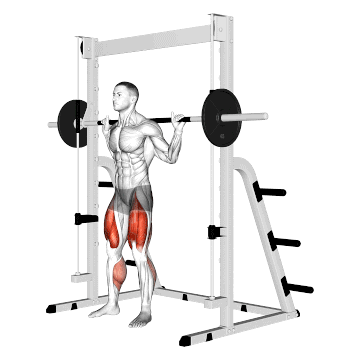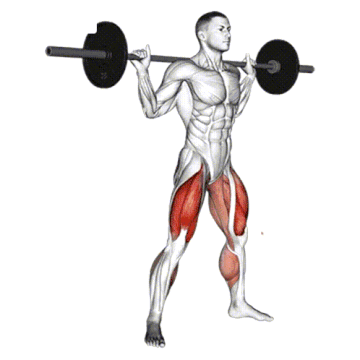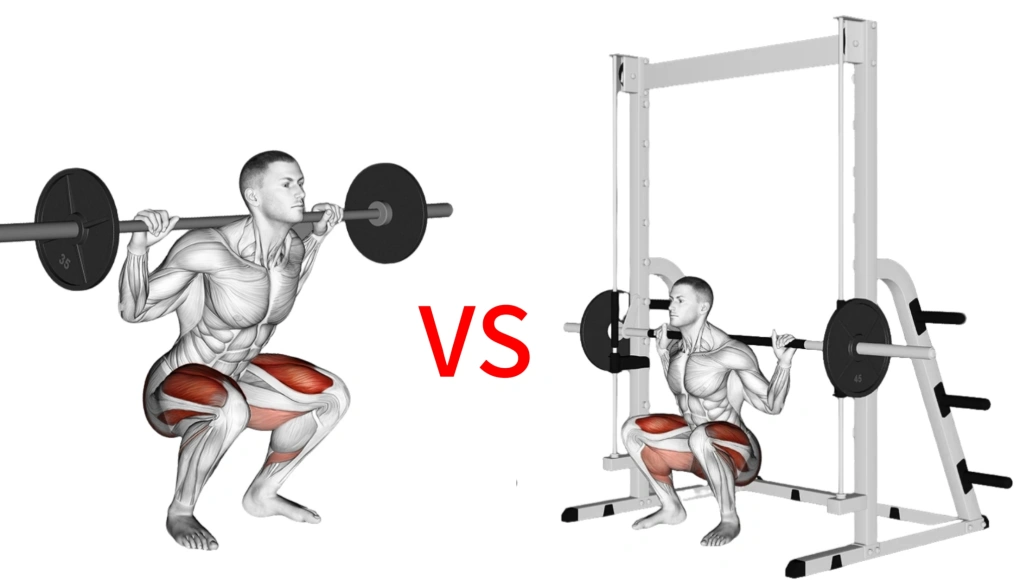Smith machine squat vs barbell squat — if you’ve ever stood in the gym not knowing which one to do, you’re definitely not alone.
You see the Smith machine wide open. Over on the other side, someone’s doing barbell squats and clearly not in a rush. You pause. “Do I wait, or just hop on the Smith?”
They’re both squats, yeah — but the way they feel? Totally different. One locks you into a fixed path. The other gives you full control — and all the responsibility that comes with it.
That’s where things get tricky.
Which one’s better for your body, your goals, your vibe in the gym?
Let’s break it down. No fluff, just real talk — so next time, you’ll actually know which one to choose.
What is a Smith Machine Squat?
A Smith machine squat is a leg exercise done on a machine with a bar that moves in a straight, fixed path.
No balancing. No wobbles. Just squat up and down on rails.
It’s simple, stable, and perfect when you want control.

🟡 What muscles does it train?
- Quads (front of your thighs) — this is where you’ll feel it most
- Glutes — more activation if you place your feet slightly forward
- Hamstrings — to a lesser extent
- Core and lower back — less demand compared to free-weight squats
🟡 How to do a Smith machine squat
- Step under the bar with feet shoulder-width apart
- Rest the bar on your upper traps (not your neck)
- Step your feet slightly forward for better balance and glute engagement
- Twist the bar to unlock it
- Squat down until your thighs are about parallel to the floor
- Push through your heels to return to standing
- Twist the bar back to lock it in place
Form tips: Keep your back straight, chest up, and knees in line with your toes.
🟡 Why people use it
- Easy to learn — great for beginners
- Feels safer — no spotter needed
- Lets you focus on legs, not balance
- Perfect for high-rep sets or rehab
- Reduces pressure on your lower back
What is a Barbell Squat?
A barbell squat is a free-weight squat done with a bar across your upper back — no rails, no machines.
You control everything: the bar, your balance, and your form. It’s harder, but also more natural and powerful.

🟡 What muscles does it train?
- Quads — still the primary movers
- Glutes — especially when you go deep
- Hamstrings — more activation than in Smith squats
- Core and lower back — big time, since you have to stabilize the weight
- Calves and upper back — help support the bar and maintain posture
🟡 How to do a barbell squat
- Stand with feet shoulder-width apart under the bar
- Place the bar on your upper traps or rear delts (low bar style)
- Grip the bar tight, elbows slightly down
- Unrack the bar and step back slowly
- Take a deep breath, brace your core
- Squat down — keep your back straight, knees tracking your toes
- Drive through your heels to stand back up
- Step forward and re-rack the bar when finished
Form tips: Keep your chest up, avoid leaning too far forward, and stay tight through your core.
🟡 Why people use it
- Builds overall strength — not just legs
- Engages your whole body — more muscles worked
- Improves balance, control, and athletic performance
- Great for building raw power and functional strength
- Preferred in powerlifting and strength training circles
Smith Machine Squat vs Barbell Squat: Key Differences
You’ve just seen what each squat does on its own — now let’s put them side by side.
Smith machine squat vs barbell squat may look similar at first glance, but they feel completely different when you’re under the bar.
| Feature | Smith Machine Squat | Barbell Squat |
|---|---|---|
| Bar path | Fixed (up and down only) | Free movement (you control it) |
| Balance required | Low — machine keeps you stable | High — you balance the bar yourself |
| Main muscles worked | Quads, some glutes | Quads, glutes, hamstrings, core |
| Core activation | Minimal | Strong — full-body engagement |
| Learning curve | Easier — good for beginners | Steeper — takes more practice |
| Safety when alone | Safer — built-in catches | Riskier — spotter recommended |
| Best for | Isolation, rehab, controlled leg work | Strength, power, athletic performance |
| Feels like | Stable, guided, slightly “robotic” | Natural, challenging, more rewarding |
🔷 So… which one should you use?
– Want stability and less guesswork? → Go Smith
– Want raw strength and balance? → Go barbell
– Want both? → Alternate depending on your goals
Which One Is Better for Your Goals?
Smith machine squat vs barbell squat — which should you do?
Here’s a simple way to choose: look at your goal, then pick the one that fits best. No guessing. Just straight answers.
🟢 You’re a beginner
→ Start with the Smith machine
- Easier to learn
- Helps you focus on form
- Less chance of mistakes
🔴 You want pure strength
→ Go with barbell squats
- Builds full-body power
- Trains balance, stability, and control
- Best long-term strength progress
🔵 You want to grow legs or glutes
→ Use the Smith machine
- Easier to isolate muscles
- Perfect for quad or glute focus
- Great for high-rep hypertrophy work
🟠 You’re injured or want safety
→ Stick with the Smith machine
- Fixed path = less joint stress
- Safer to train alone
- More control, less risk
🟣 You want full-body challenge
→ Choose barbell squats
- Demands more from your body
- Trains legs, core, and back together
- Feels more “real” and athletic
Can You Use Both Smith Machine and Barbell Squats?
Yes — and honestly, combining them is smarter than picking just one.
Barbell squats and Smith machine squats work differently, but they can support each other.
Use one for strength. The other for control. Together? You cover more ground.

They don’t overlap — they complement each other.
There are a few smart ways to mix both into your routine:
🔹 Option 1: Alternate by day
– One leg day with barbell squats
– Another leg day with Smith squats
Perfect for a 2-day lower body split.
🔹 Option 2: Heavy + burnout
– Start with barbell squats (low reps, heavy weight)
– Finish with Smith squats (high reps, slow tempo)
You get both strength and muscle fatigue in one session.
🔹 Option 3: Rotate based on energy
– Feeling strong? → Do barbell squats
– Feeling low or sore? → Switch to Smith squats for safer reps
Sample 2-Day Leg Split
| Day | Main Squat | How to Use It |
|---|---|---|
| Leg Day 1 | Barbell Squat | Strength focus — low reps, heavier weight |
| Smith Machine Squat | Finisher — high reps to burn out your quads | |
| Leg Day 2 | Smith Machine Squat | Control + volume — medium reps, slow tempo |
| Front/Goblet Squat | Add light core/posture work if you want |
🟩 Bottom line:
You don’t have to choose.
Use barbell squats for strength. Use Smith machine squats for control.
Both together = better leg training.
Each has its role. Each hits a different angle.
You don’t need to pick sides.
Just train with purpose.
Listen to your body.
Pick the squat that fits your goal that day — and do it well.

Hi, I’m Alex Carter, part of the editorial team at Leadman Fitness. We specialize in crafting premium custom racks, cable machines, functional trainers, and strength accessories for home and commercial gyms. With a background in competitive powerlifting and gym design consulting, I’ve spent years testing gear under heavy loads and optimizing layouts for efficiency.
I focus on translating real-world user frustrations—like space limitations, budget constraints, or durability needs—into actionable solutions. By collaborating directly with our engineers and facility owners, I ensure our custom equipment evolves to solve the unspoken challenges lifters face daily. What I share isn’t textbook advice; it’s battle-tested insight from racks I’ve welded, cables I’ve replaced, and gym floors I’ve trained on.
